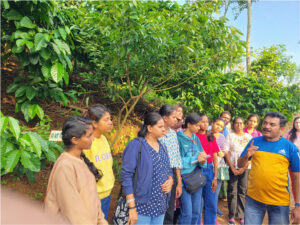
Coffee is a beloved beverage throughout the world. Some enjoy it as black coffee, others prefer it with milk. For many, it’s not just a beverage but a way of life. This aromatic drink is made from the roasted beans of a tropical plant and has a rich cultural significance.
South India has long been the epicentre of coffee culture in India. Coorg, nestled in Karnataka, is one of the top coffee-producing regions in the country. Known as the ‘Coffee Land of India’, Coorg is renowned for its lush green landscapes, hilly slopes and extensive coffee plantations. Because of its natural beauty, Coorg is nicknamed the ‘Scotland of India’.
In mid-November, the Department of Botany, JNRM organized a three-day educational tour to Coorg for its M.Sc. final-year students. I was excited to be part of the group of 11 students, accompanied by our HOD and a lady staff member. We reached Coorg, also known as Madikeri, on 18th of November.
We travelled to Coorg from Mysore by road. As we climbed the hilly terrain, I saw the change in vegetation. On the way, we stopped at Nisargadhama, a beautiful delta formed by the river Kaveri. We explored the area and felt the cool water of the river. It was very refreshing. As we approached Coorg, the lush green forests and distant mountains started appearing. These are the biodiversity-rich forests of the Western Ghats, which we studied in our theory classes. Seeing these rich natural forests was a mesmerizing experience for me. The sight of coffee plantations on the steep slopes was equally breathtaking!
There is an interesting folklore story of how coffee was introduced in Coorg. In the 17th century, Sufi Saint Baba Budan smuggled seven coffee seeds from Yemen and planted them on the slopes of the Western Ghats. However, large-scale cultivation only began during British colonial rule in the 19th century. This transformed Coorg into one of the primary coffee-growing regions of India.
On 19th November, our group toured a coffee plantation named Mountain View Coffee Plantation. As we walked along the narrow lanes of the hilly slopes, I inhaled the fresh aroma of the coffee bushes. These bushes were neatly trimmed and maintained at a uniform height. This gave the landscape an even appearance. Little clusters of green and burgundy coffee cherries hung from the branches. The sight was stunning.
Our guide explained that two coffee varieties are grown in Coorg: Arabica and Robusta. Arabica is known for its smooth, aromatic flavour and has oval-shaped beans with lower caffeine content. It constitutes about 60–70% of the world’s coffee production. Robusta, on the other hand, is strongly flavoured with a higher caffeine content and has smaller, rounded beans. It is ideal for espresso blends and traditional South Indian filter coffee.
I learned that coffee in India is grown under shades of tall trees like rosewood, wild fig and jackfruit. This practice imparts a unique aroma and flavour to coffee as well as supports biodiversity. Intercropping is also a common practice with spices like pepper grown alongside coffee plants. This is a sustainable agricultural practice and also boosts productivity.
The guide also explained to us about blending Robusta coffee with Chicory in an 80:20 ratio. Chicory imparts unique flavour and enhances the taste of the brew. This blend is called ‘Kaapi’, a South Indian filter coffee which is famous for its strong and bubbly froth.
During the visit, we learned about the famous Civet Coffee, also known as Kopi Luwak. It is one of the world’s most exotic and expensive coffees. It is extracted from coffee beans that have been digested and excreted by the Asian palm civet. Our HOD had the privilege of tasting it and described it as strong and intense in flavour!
The guide helped us understand the journey of coffee beans from farm to cup. We witnessed the various steps and enjoyed the final product: a hot cup of the brew. I also learned new terms like Monocot, Dicot and Green Coffee. Usually, most coffee berries contain two beans and are referred to as dicot beans. Monocot beans, which consist of a single bean per berry, are considered A-grade coffee due to their smoother texture. On the other hand, Green coffee beans are unroasted, rich in antioxidants and have many health benefits.
Before this visit, I was not a coffee enthusiast. However, our visit to the coffee plantations of Coorg has changed my perspective. As I learned the journey of coffee from bean to brew, my appreciation for this beverage has grown a lot. This experience of walking through the lush coffee plantations of Coorg will stay with me for a lifetime!
(B Laxhmi is pursuing her master’s in Botany at Jawaharlal Nehru Rajkeeya Mahavidyalaya, Sri Vijaya Puram, A & N Islands)
source: http://www.andamansheekha.com / Andaman Sheekha / Home / by B Laxmi / December 02nd, 2024

